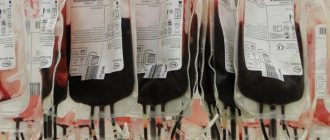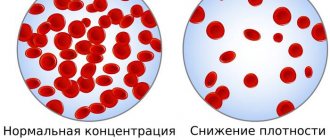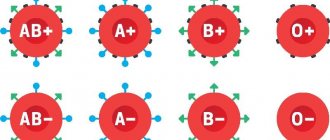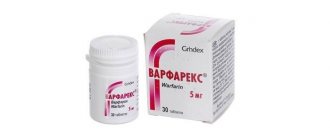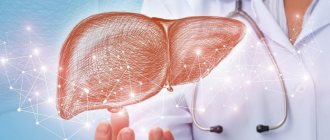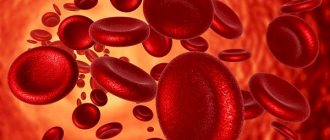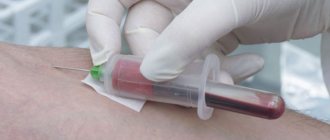Detailed description of the study
Immunoglobulins (Ig, antibodies) are serum proteins that are factors of humoral immunity. This subtype of the immune system protects the human body from various extracellular microorganisms (mainly bacteria, helminths) and their toxins.
Immunoglobulins have a general structural plan, but differ from each other in some structural areas. Based on this, five classes of immunoglobulins are distinguished: M (IgM), G (IgG), A (IgA), E (IgE) and D (IgD). This laboratory test is aimed at determining the concentration of immunoglobulins IgA, IgM and IgG in the blood.
IgA immunoglobulins are predominantly present in the secretions of glandular organs: saliva, digestive juice, secretions of the nasal mucosa and mammary gland. In the blood, the content of these antibodies is limited to 10-15% of the total amount of all immunoglobulins.
One of the key functions of class A immunoglobulins is the body's first line of defense on mucosal surfaces. IgA prevents the penetration of various microorganisms and their waste products. Although IgA does not have bactericidal activity, it plays an important role in neutralizing bacterial toxins. It is also known that immunoglobulins A are widely represented in colostrum (breast milk) and can provide specific immune protection for the newborn against various infections.
Class M immunoglobulins have a complex structure and the highest molecular weight. In this regard, IgM antibodies cannot be transmitted (through the placental barrier) from the mother’s body to the fetus during pregnancy.
IgM perform one of the leading functions in immune defense; they are the earliest antibodies that are produced in response to foreign molecules (antigens). Immunoglobulins M can participate in the neutralization of antigens independently, as well as as part of a complex immune complex - the complement system. The greatest activity of IgM is manifested against many bacteria - pathogens of pneumonia, meningitis, Haemophilus influenzae and others.
IgG antibodies are the dominant class in terms of the number of molecules in blood serum - they account for 75-80% of all immunoglobulins. IgG is predominantly produced after IgM antibodies during the secondary immune response (when a foreign molecule enters the body again). This property determines one of the features of IgG - these antibodies contribute to the long-term immune protection of the body from various bacteria, viruses, helminths, protozoa and their metabolic products.
Due to their small size, IgG are the only immunoglobulins that can cross the placental barrier during pregnancy. They are considered the main antibodies that provide immunity to a newborn baby during the first 3-6 months of his life.
The main pathologies with immunoglobulins of classes A, M and G are associated with a violation of their quantity. The lack of these antibodies is often associated with immunodeficiency, which can have various origins. Deficiency of IgA, IgM and IgG may be accompanied by the appearance or exacerbation of infectious diseases (respiratory tract, ENT organs, etc.); autoimmune (rheumatoid arthritis, systemic lupus erythematosus, etc.) and allergic pathologies (rhinitis, asthma, etc.).
The causes of excess antibodies of the IgA, IgM and IgG classes are most often acute or recurrent inflammatory diseases (infectious and non-infectious nature), as well as oncohematological pathologies associated with tumor degeneration of B-lymphocytes and uncontrolled formation of immunoglobulins of one or more classes.
This laboratory test is recommended for patients to assess the humoral part of the immune system as part of the diagnosis of (acute/chronic) infectious, autoimmune, hematological and oncological diseases, as well as immunodeficiency states. In the Hemotest laboratory you can also additionally undergo a comprehensive study of humoral immunity.
A detailed description of the studies and reference values are presented on the pages with descriptions of individual studies.
Different results in different laboratories. Where is the truth?
Why is the IgG antibody value of 2 considered positive in one laboratory, and negative in another? How do you understand that immunity has been formed? And who to believe?
Today we talk about all the nuances of laboratory diagnostics of the immune response to coronavirus.
What are reference intervals?
The results of some studies are given to patients in the format of “yes” and “no”; such studies are called qualitative. There are quantitative and semi-quantitative tests. Together with them, the laboratory issues reference interval values.
The reference interval is the range of indicator values that is average for a healthy person in the population.
Why do they differ from one laboratory to another?
Manufacturers of equipment and test systems set their reference values. And in different laboratories the same analysis can be carried out using different test systems.
For example: IgG values for the test system are considered negative:
- Mindray (China) <10;
- Abbott (USA)<1;
that is, you will be considered not to have been in contact with the infection if the results show 5 units for the Chinese test system and 0 for the American one.
That is why the doctor who interprets the result should always rely on the reference interval.
Why else might antibody tests show incorrect results?
Antibody tests are based on the principle of antigen-antibody reaction. Where the antibody is an immunoglobulin and the antigen is the protein on the surface of the virus.
And different test systems detect different antigen proteins.
For example, the Abbot test system detects IgG antibodies to the nucleocapsid (N) protein. And the Mindray and Vector-Best test system detects IgG to the spike (S) protein.
In total, there are 4 types of proteins that test systems can identify:
- S1 (spike protein domain)
- S2 (spike protein domain)
- RBD (a fragment of the S1 protein; neutralizing antibodies are synthesized against it)
- N (nucleocapsid)
First of all, you need to understand the purpose for which the IgG test is taken, and based on this, choose the test:
- To find out whether post-vaccination immunity has formed: you need to take an IgG test for the spike (S) protein. The Sputnik V vaccine contains a section of the virus genome that encodes the S protein. And if you take an IgG test for the nucleocapsid (N) protein, it will show that immunity has not been formed. But in fact, the body will be familiar with the infection, simply antibodies will be synthesized to another of its proteins.
- Has there been contact with infection and has immunity been formed? In this case, it is better to get tested for antibodies to two proteins, N and S, in order to be more likely to “catch” antibodies to both viral proteins.
For personal advice on selecting the right test, you can contact the hotline. Doctors at the Doctor Q service help you select tests, interpret their results, and choose the right strategy for further diagnosis for free.
LABquest - Your correct diagnostic path!
What else is prescribed with this study?
Humoral immunity (immunoglobulins IgA, IgM, IgG, IgE, circulating immunocomplexes, complement components C3, C4)
17.51. Ven. blood 8 days
2,580 ₽ Add to cart
Immune status (screening) (Phagocytic activity of leukocytes, cellular immunity, total immunoglobulin IgE, immunoglobulins IgA, IgM, IgG)
27.960. Ven. blood 3 days
5 680 ₽ Add to cart
Total immunoglobulin IgE
17.2. Ven. blood 1 day
410 ₽ Add to cart
Cellular immunity (T-lymphocytes, T-helpers, T-cytotoxic cells, Immunoregulatory index, B-lymphocytes, NK-T cells, NK cells, Leukocyte formula)
17.50. Ven. blood 3 days
4 160 ₽ Add to cart
Serum paraprotein typing using immunofixation
50.28.2181 Ven. blood 14 days
3,380 ₽ Add to cart
General blood analysis. Table of reference values
| Index | Patient gender | Norm |
| Hemoglobin | Men Women | 130-170 g/l 120-150 g/l |
| Red blood cells | Men Women | 4.0-5.0 1012/l 3.5-4.7 1012/l |
| Leukocytes | — | 4.0-9.0×109/l |
| Hematocrit (the ratio of the volume of plasma and cellular elements of blood) | Men Women | 42-50% 38-47% |
| Average red blood cell volume | — | 86-98 µm3 |
| Leukocyte formula | — | Neutrophils:
Monocytes: 3-11% Eosinophils: 0.5-5% Basophils: 0-1% |
| Platelet count | — | 180-320·109/l |
| Erythrocyte sedimentation rate (ESR) | Men Women | 3 - 10 mm/h 5 - 15 mm/h |
References
- Encyclopedia of clinical laboratory tests / ed. WELL. Titsa. - M.: Labinform, 1997. - P. 213-215, 223-226.
- JVaillant, A., Jamal, Z., Ramphul, K. Immunoglobulin. In: StatPearls, 2021.
- Sathe, A., Cusick, J. Biochemistry, Immunoglobulin M. StatPearls Publishing, 2021.
- Histology (introduction to pathology) / ed. E.G. Ulumbekova, Yu.A. Chelysheva. - M.: GEOTAR-Media, 1997. - P. 528 – 530.
- Kumar, V., Abbas, A., Fausto, N. et al. Robbins and Cotran Pathologic Basis of Disease, 2014. - 1464 p.
Decoding the biochemical blood test
A biochemical blood test in adults shows whether the most important internal organs are functioning correctly: liver, pancreas, kidneys, cardiovascular system, muscles. So creatinine speaks about the work of the kidneys, as well as the state of the muscular system, albumin and bilirubin - about the work of the liver, the level of glucose, cholesterol and triglycerides in the blood - about metabolism. In addition, a biochemical blood test can reveal a lack of essential microelements in the body: you will receive their reference values along with the test results. The normal results of blood tests indicate the coordinated functioning of the main organs; deviation from the norms is a reason for further diagnosis and consultation with a doctor.
Research results
The results of the study are presented in the following indicators:
- negative;
- positively;
- doubtful.
If the result is negative, the reference values in this case are 0.0 - 12.2 PFU/ml. This result indicates the absence or very low level of class G antibodies to the virus. A negative result can be obtained in a patient who is in the earliest incubation stage of the disease.
Reference values for a questionable result are 12.0 – 15.0 PFU/ml. Such data indicate a low level of IgG antibodies to COVID-19. For clarification, repeated testing is recommended after 7–14 days.
Reference values for a positive result are ≥ 15.0 CFU/ml. This result indicates the presence of high levels of class G antibodies in the blood.
Blood test for hormones when planning pregnancy
It is very important to take a blood test for hormones when planning a pregnancy. Timely assessment of hormonal levels will help avoid possible problems.
The main hormones that are checked when planning pregnancy:
- FSH (follicle-stimulating hormone)
- in women, is responsible for the growth of the egg (follicle) in the ovary. In men, it is one of the main sex hormones that regulate reproductive function. - LH (luteinizing hormone)
- in women, ensures completion of the maturation of the egg in the follicle and subsequent ovulation (rupture of the follicle and release of the egg). In men, it affects the maturation of sperm. - Prolactin
– stimulates lactation after childbirth. During pregnancy, it reduces the release of FSH. If there is no pregnancy, an increased amount of prolactin can lead to a pathological deficiency of FSH and prevent conception. - Estradiol
- affects all female genital organs. - Progesterone (pregnancy hormone)
is produced after the egg matures. Without this hormone, a fertilized egg cannot attach to the uterus. Lack of progesterone can cause miscarriage. - Testosterone
is a male sex hormone; an increased amount of testosterone in women can lead to miscarriage, and a decreased amount in men can lead to decreased sperm quality. - DEA sulfate
(DEA-s or DEAS) is produced in small quantities in the body of women. Increased concentrations of this hormone can lead to infertility. - Thyroid hormones.
Thyroid dysfunction can also cause infertility.
Preparing for a hormone test
The amount of hormones in the blood depends on the time of day, since there is a daily rhythm of secretion (release of hormones). Blood for hormonal analysis should be taken in the morning, on an empty stomach.
In women, hormonal levels also depend on the stage of the menstrual cycle. The most favorable days for analysis are days 5-7 of the cycle, starting from the first day of menstruation.
On the eve of the test, you should not drink alcohol, and you should also avoid increased physical activity and stressful situations. It is advisable not to smoke for an hour before the test.
A week before the test, you must stop taking hormonal medications. If you are prescribed medication, discuss this with your doctor; the test may have to be postponed.
IgG immunoglobulin test: how to decipher
Interpretation of the study results is the task of the attending physician; it is not worth making a diagnosis on your own based on one study, as well as self-medicating.
Reference values for immunoglobulin IgG depend not only on gender, but also on the age of the patient (measurement in g/l):
- at the age of 0 - 1 month, the norm for boys is 3.97 - 17.65, for girls - 3.91 - 17.37;
- 1-12 months the norm for boys is 2.05 - 9.48, for girls - 2.03 - 9.34;
- 1-2 years the norm for boys is 4.75 - 12.1, girls - 4.83 - 12.26;
- 2-80 years old, the norm for men is 5.4-18.22, for women – 5.52-16.31.
An increase in IgG levels indicates that, most likely, there is a coronavirus infection in the body at the last stage or the patient has recently had it. However, other diseases can also be the cause: infections, HIV, sarcoidosis, autoimmune diseases and others. That is why a doctor must make a diagnosis based on a complete medical history.
Specific protein
This is a substance that is produced exclusively by prostate tissue. Determined if organic lesions of the prostate are suspected - benign or malignant. An increase in PSA is observed during:
- prostatitis;
- infectious organ lesions;
- hyperplasia;
- malignant neoplasm.
According to statistics, among patients whose PSA value is in the range of 4-10 ng/ml, the biopsy detected malignant cells in only 25%.
The ratio of free to total PSA in prostate adenoma is usually higher than in cancer. But to confirm any of the diagnoses, additional diagnostic methods are needed.
